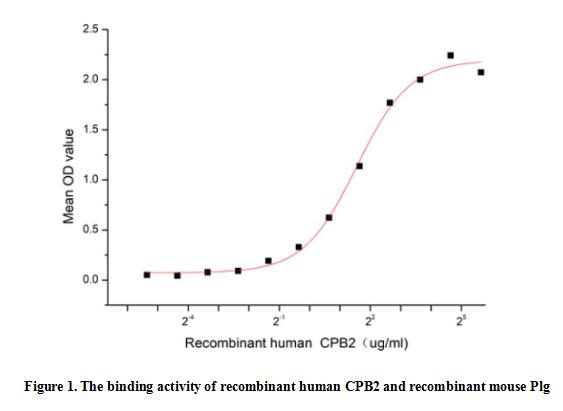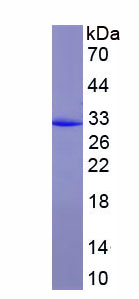Active Carboxypeptidase B2 (CPB2) 

TAFI; CPU; PCPB; Thrombin Activatable Fibrinolysis Inhibitor; Plasma Carboxypeptidase B; Carboxypeptidase U
- UOM
- FOB US$ 232.00 US$ 580.00 US$ 1,160.00 US$ 3,480.00 US$ 8,700.00
- Quantity
Overview
Properties
- Product No.APA615Hu01
- Organism SpeciesHomo sapiens (Human) Same name, Different species.
- ApplicationsCell culture; Activity Assays.
Research use only - DownloadInstruction Manual
- CategoryMetabolic pathwayHematology
- Buffer FormulationPBS, pH7.4, containing 0.01% SKL, 5% Trehalose.
- Traits Freeze-dried powder, Purity > 97%
- Isoelectric Point8.7
Sign into your account
Share a new citation as an author
Upload your experimental result
Review

Contact us
Please fill in the blank.
Activity test

Carboxypeptidase B2 (CPB2), also known as carboxypeptidase U (CPU) and thrombin-activatable fibrinolysis inhibitor (TAFI), is a member of the peptidase M14 family.
CPB2 is synthesized by the liver and circulates in plasma as a plasminogen-bound zymogen. It can cleave C-terminal arginine or lysine residues from biologically active peptides such as kinins or anaphylatoxins in the circulation thereby regulating their activities and Down-regulates fibrinolysis by removing C-terminal lysine residues from fibrin that has already been partially degraded by plasmin. Besides, Plasminogen (Plg) has been identified as an interactor of CPB2, thus a functional binding ELISA assay was conducted to detect the interaction of recombinant human CPB2 and recombinant mouse Plg. Briefly, CPB2 was diluted serially in PBS with 0.01% BSA (pH 7.4). Duplicate samples of 100 μl were then transferred to Plg-coated microtiter wells and incubated for 1h at 37℃. Wells were washed with PBST and incubated for 1h with anti-CPB2 pAb, then aspirated and washed 3 times. After incubation with HRP labelled secondary antibody for 1h at 37℃, wells were aspirated and washed 5 times. With the addition of substrate solution, wells were incubated 15-25 minutes at 37℃. Finally, add 50 µL stop solution to the wells and read at 450/630 nm immediately. The binding activity of recombinant human CPB2 and recombinant mouse Plg was shown in Figure 1, the EC50 for this effect is 2.9 ug/mL.
Usage
Reconstitute in 10mM PBS (pH7.4) to a concentration of 0.1-1.0 mg/mL. Do not vortex.
Storage
Avoid repeated freeze/thaw cycles. Store at 2-8°C for one month. Aliquot and store at -80°C for 12 months.
Stability
The thermal stability is described by the loss rate. The loss rate was determined by accelerated thermal degradation test, that is, incubate the protein at 37°C for 48h, and no obvious degradation and precipitation were observed. The loss rate is less than 5% within the expiration date under appropriate storage condition.
Increment services
-
 BCA Protein Quantification Kit
BCA Protein Quantification Kit
-
 Molecular Mass Marker for Protein
Molecular Mass Marker for Protein
-
 Monoclonal Antibody Customized Service
Monoclonal Antibody Customized Service
-
 Polyclonal Antibody Customized Service
Polyclonal Antibody Customized Service
-
 Protein Activity Test Experiment Service
Protein Activity Test Experiment Service
-
 Electrophoretic Mobility Shift Assay (EMSA) Experiment Service
Electrophoretic Mobility Shift Assay (EMSA) Experiment Service
-
 Buffer
Buffer
-
 Lentivirus Packaging Experiment Service
Lentivirus Packaging Experiment Service
-
 Adenovirus Packaging Experiment Service
Adenovirus Packaging Experiment Service
-
 Real Time PCR Experimental Service
Real Time PCR Experimental Service
-
 Spike RBD Protein (S-RBD)
Spike RBD Protein (S-RBD)
-
 Protein G
Protein G
-
 Protein A
Protein A
Citations
- Levels of thrombin-activatable fibrinolysis inhibitor and platelet-activating factor in recurrent pregnancy loss patientsPubmed:26927250
- Plasma proteins as potential targets of abnormal Savda syndrome in asthma patients treated with unique Uighur prescriptionpubmed:28672924
- Thrombin activatable fibrinolysis inhibitor as an indicator of the severity of acute pancreatitisPubmed:22230218







